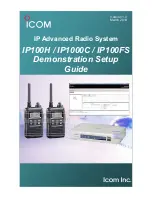
Section 1
;
Packet Radio “The Basics
”
A Packet Primer for the new Packeteer
__ Page 10
A PacketRadio FREQUENCY GUIDE FOR THE NEW PACKET OPERATOR:
This guide is for information purposes only, and is subject to change. Some changes in future band-plans may cause
changes in the application of certain Packet frequencies. A possible change in the 219.050 to 219.950 is one example of
Packet frequency changes. The 219 Mhz band is allocated for future trunks and backbone "only." Some frequencies are
used for specific Packet modes. Note that frequencies are in MHz:
80 Meters
3.606 Packet
3.630 Packet
3.642 Packet
40 Meters
7.090-7.100 Packet
30 Meters
10.145-10.150 Packet
20 Meters
14.101-14.110 Packet
14.230 SSTV
17 Meters
18.100-18.110 Packet
15 Meters
21.099-21.105 Packet
10 Meters
28.099-28.105 Packet
28.150 -28.190 1200 baud Packet
6
Meters
50.60-51.78 Packet
50.62 Packet calling freq
51.12 9600 baud “backbone only”
2 Meters
144.910-145.090
Packet (every 20 kHz)
145.510-145.790
Packet (every 20 kHz)
144.910 through 144.950
Mhz used for DX Spotting and
NOS operations.
144.970, 144.990, 145.030, 145.070 145.530, 145.550,
145.570, 145.590, 145.610, 145.630, 145.650, 145.670,
145.690, 145.730, and 145.750
Mhz are used as Local
Area Network (LAN's) and often ported into high-speed
backbones and trunks.
145.010, & 145.050
is most often used as BBS
forwarding and local BBS connects.
145.090, 145.510, & 145.710
are sometimes employed as
DX spotting nets.
145.770
Nationwide Keyboard to keyboard and
emergency Packet communications only. Some areas
use 145.770 Mhz for
emergency communications in
addition to keyboard to keyboard communications.
In some east coast areas 144.390 Mhz is used with
Automatic Packet Reporting Systems (APRS), and as a
DXCluster or DX spotting network frequency.
222 MHz
223.52-223.64 Packet











































